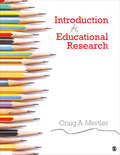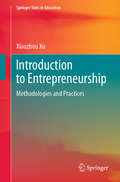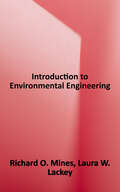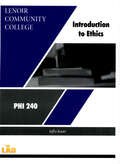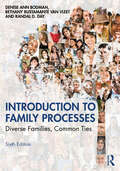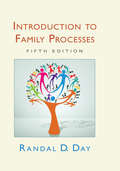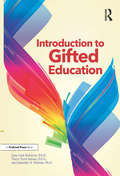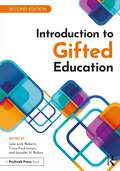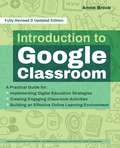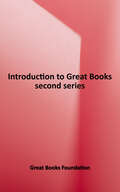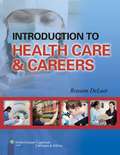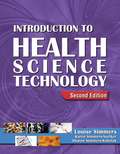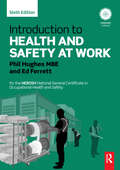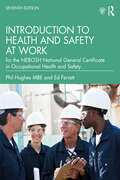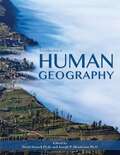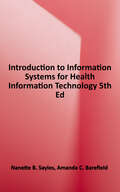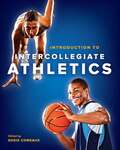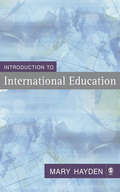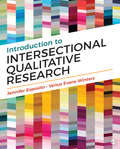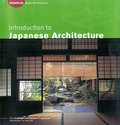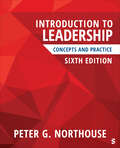- Table View
- List View
Introduction to Educational Research: Mertler: Introduction To Educational Research + Hoy: Quantitative Research In Education
by Dr Craig A. MertlerIntroduction to Educational Research guides readers through the various steps of the research methods process to help plan and compose their first educational research project. Through comprehensive chapter content and in-text exercises, readers learn how to prepare a research plan, gather and analyze data, address research questions and hypotheses, and organize reports of their projects. The book is practical and student-friendly; Dr. Craig A. Mertler uses a conversational writing style with non-technical language to help students clearly understand and apply research concepts with no prior familiarity with the principles, procedures, or terminology.
Introduction to Educational Research: Mertler: Introduction To Educational Research + Hoy: Quantitative Research In Education
by Dr Craig A. MertlerIntroduction to Educational Research guides readers through the various steps of the research methods process to help plan and compose their first educational research project. Through comprehensive chapter content and in-text exercises, readers learn how to prepare a research plan, gather and analyze data, address research questions and hypotheses, and organize reports of their projects. The book is practical and student-friendly; Dr. Craig A. Mertler uses a conversational writing style with non-technical language to help students clearly understand and apply research concepts with no prior familiarity with the principles, procedures, or terminology.
Introduction to Entrepreneurship: Methodologies and Practices (Springer Texts in Education)
by Xiaozhou XuThis textbook helps readers increase their entrepreneurial knowledge, improve their competences, and expand their entrepreneurial thinking.The book consists of nine chapters: Expand Entrepreneurial Vision, Improve Entrepreneurial Quality, Prepare for Entrepreneurship Education, Identify Entrepreneurial Opportunities, Build An Entrepreneurship Team, Compose the Business Plan, Planing Entrepreneurial Strategy, Avoid Entrepreneurial Risks, and Optimize Entrepreneurial resources. It allows readers new to the area to gain an understanding of entrepreneurship and provides a solid basis for starting a business in the future. Each chapter includes learning objectives and “leads” at the beginning and ends with review and “think and discuss” sections.
Introduction to Environmental Engineering
by Richard O. Mines Laura W. LackeyFor introductory courses in engineering at the freshmen and sophomore levels at both community colleges and universities. An environmental engineering text for beginning students. In Introduction to Environmental Engineering, authors Richard Mines and Laura Lackey explain complicated environmental systems in easy-to-understand terms, providing numerous examples to reinforce the concepts presented in each chapter.
Introduction to Ethics: PHI-240
by Jeff KautzPHI 240 - Introduction to Ethics(Coll/Tran)Class Hours: 3Lab Hours: 0Clinical/Work Exp. Hours: 0Credit Hours: 3This course introduces theories about the nature and foundations of moral judgments and applications to contemporary moral issues. Emphasis is placed on moral theories such as consequentialism, deontology, and virtue ethics. Upon completion, students should be able to apply various ethical theories to moral issues such as abortion, capital punishment, poverty, war, terrorism, the treatment of animals, and issues arising from new technologies.
Introduction to Excel and SPSS: A Stepwise Approach to Statistical Software
by Susan D. Croll Michelle L. FowlerIntroduction to Excel and SPSS: A Stepwise Approach to Statistical Software by Susan D. Croll and Michelle L. Fowler
Introduction to Family Processes: Diverse Families, Common Ties
by Randal D. Day Denise Ann Bodman Bethany Bustamante Van VleetIntroduction to Family Processes: Diverse Families, Common Ties serves to provide an explanation of the complex workings of inner family life. The text primarily focuses on family processes and dynamics (the "inside" of families) as opposed to sociological trends, political topics, or the individual psychological approach. The text further presents the research underlying these processes and effectively presents ways to increase the positive aspects of family life. This edition has been updated to include current research and contemporary topics. The text has been divided into four parts: Foundations, Building and Establishing Families, Maintaining Families, and Change/Turbulence/Gains/Losses. While the research methods chapter still provides an introductory examination of family science research, it now includes an expanded discussion on research design, methods, and advances in the area. A new chapter, titled "Forgiveness, Kindness, Hope, and Gratitude" has been incorporated to amplify positive family processes and highlight emerging research. This edition provides added emphasis on diverse families (e.g., race/ethnicity, family structure, LGBTQIA, ability, culture, and family formation), and each chapter includes a new "Discussions in Diversity" section related to that chapter. The authors have consciously included an epilogue as a way of reflecting on what they have learned, along with what they hope to learn in the future. Aimed at courses related to family studies and family dynamics, this text provides a comprehensive review of family processes. Whether it is used for undergraduate or graduate classes, professional growth, or personal enrichment, the text assists readers in enhancing the positive aspects of family life, avoiding undesirable aspects, and more effectively managing the challenges and obstacles families face that cannot be avoided. Thus, the text holds an appeal for people who live (or will live) in families, as well as those who want to work with families.
Introduction to Family Processes: Fifth Edition
by Randal D. DayWhat goes on "behind closed doors" in families is examined in this text. Through his storytelling style, Randy Day introduces readers to the family processes approach – the strategies and behaviors families use to achieve goals. The emphasis is on how families work and interact rather than on the psychological, sociological, or economic processes. It examines emotions in families, communication, relationship formation/dissolution, family rituals, and power and conflict. Chapters open with a Preview and conclude with a Summary, Study Questions, Key Terms, and Suggested Readings. Principle Boxes highlight key concepts and a Glossary defines the key terms listed at the ends of the chapters. Significantly updated with 50% new material including many new references and examples, the new edition features: A new chapter that introduces the discipline’s methodology A new chapter on relationship formation including partner selection, falling in love, commitment, sexuality, passion, and intimacy A new design reformatted to tie in with the book’s website at http://www.psypress.com/family-processes which now contains the Chapter Activity Questions that reinforce critical thinking skills, the Journal Activities that strengthen students' personal connection to the material, and the chapter Previews and Key Terms for review purposes An Instructor’s Web Resource at http://www.psypress.com/family-processes with small group and in-class exercises, lecture outlines in PowerPoint, topics for debate, suggested films, and multiple-choice, true/false, matching, and essay questions More material on the role of gender, power, genetics, and personality in relationships; families from diverse cultural and ethnic backgrounds and the impact of work and technology on the family; the changing nature of family structures including single parenting and gay unions; and stresses in family life. Written for undergraduate courses on family processes, family dynamics, family life, the family, and/or marriage & family interaction taught in family studies, human development, psychology, sociology, social work, education, consumer sciences, home economics, health, and nursing departments, this book also appeals to those who want to maximize the positive parts of family life and manage the inevitable challenges.
Introduction to Gifted Education
by Tracy Ford Inman Julia Link Roberts Jennifer RobinsIntroduction to Gifted Education is the definitive textbook designed for courses that introduce teachers to gifted education, whether that is in graduate school or in certification or continuing development programs for teachers. The book is inclusive in nature, addressing varied approaches to each topic while relying on no single theory or construct. The book includes chapters that focus on critical topics such as gifted education standards, social-emotional needs, cognitive development, diverse learners, identification, programming options, creativity, professional development, and curriculum. The book provides a comprehensive look at each topic, including an overview of big ideas, its history, and a thorough discussion to help those new to the field gain a better understanding of gifted students and strategies to address their needs. A rich companion piece supports the text, providing practical strategies and activities for the instructor (designed for both online classes and face-to-face classes). Texas Association for the Gifted and Talented 2018 Legacy Book Award Winner—Scholar
Introduction to Gifted Education
by Julia Link RobertsNow in its Second Edition, Introduction to Gifted Education presents a well-researched yet accessible introduction to gifted education, focusing on equity and supporting diverse learners. Inclusive in nature, this essential text is filled with varied perspectives and approaches to the critical topics and issues affecting gifted education. Chapters cover topics such as gifted education standards, social-emotional needs, cognitive development, diverse learners, identification, programming options, creativity, professional development, and curriculum. The book provides a comprehensive look at each topic, including an overview of big ideas, its history, and a thorough discussion to help those new to the field gain a better understanding of gifted students and strategies to address their needs. Filled with rich resources to engage readers in their own learning, Introduction to Gifted Education, Second Edition is the definitive textbook for courses introducing teachers to gifted education.
Introduction to Google Classroom
by Annie BrockLearn to take your classroom curriculum digital using Google Classroom&’s unique file sharing features. Introduction to Google Classroom will help teachers of all grade levels master the basics of communication and education using the Google Classroom file sharing service. Learn how to connect with students, control access to lessons, distribute assignments, and update your class calendar. Google Classroom newbie? No worries! Experienced educator and author Annie Brock takes readers step-by-step through the most common Google Classroom features and terminology. Packed with tips, tricks, troubleshooting, helpful screenshots, and activity ideas to keep students of all ages engaged, this book is indispensable as the future of teaching continues to evolve.
Introduction to Great Books: Second 2 Series
by Great Books FoundationThe Leader's Guide includes tips on answering a prereading question, reading twice and taking notes, sharing participants' questions and notes, textual analysis, Shared Inquiry discussion, and post-discussion writing. Perfect for teachers or book group leaders.
Introduction to Health Care and Careers
by Roxann Delaet<p><i>Introduction to Health Care and Careers</i> provides students beginning their health care education with the fundamentals they need to develop their personal and professional skills, understand their chosen profession, and succeed in the world of health care. It meets the growing market demand for a book that gives the best of both worlds—skill development and career choice information. The text begins with today’s health care system, health care economics, and law and ethics, providing important context for the personal, professional, and workplace skills that follow. From there, students move on to an overview of careers in health care and detailed profiles of the most in-demand professions. The book closes with brief chapters on anatomy and physiology to prepare students for the rest of their health care education. <p>With its student friendly approach,<i>Introduction to Health Care and Careers</i> is the essential resource for introductory health care courses, striking the perfect balance between skill development and up-to-date career choice information–everything health care students need to succeed.</p>
Introduction to Health Science Technology
by Karen Simmers-Nartker Louise Simmers Sharon Simmers-KobelakThis text overviews the health care field for beginning students in health sciences or health occupations, covering standard precautions, cultural diversity, medical math, teamwork and leadership, and computer technology. Learning features include chapter objectives and summaries, Internet exercises, and review questions, plus step-by-step directions of basic procedures in the field illustrated with color photos. A separate workbook and CD-ROM are available. Simmers is a member of the University of Maryland Nursing Alumni Association. Annotation (c)2003 Book News, Inc. , Portland, OR (booknews. com)
Introduction to Health and Safety at Work: for the NEBOSH National General Certificate in Occupational Health and Safety
by Phil Hughes Ed FerrettIntroduction to Health and Safety at Work covers the fundamentals of occupational safety and health for the thousands of students who complete the NEBOSH National General Certificate in Occupational Health and Safety each year. Fully revised in alignment with the April 2015 syllabus, this sixth edition provides students with all they need to tackle the course with confidence. The highly illustrated content covers all of the essential elements of health and safety management, the legal framework, risk assessment and control standards and also includes checklists, report forms and record sheets to supplement learning. Aligned to the NEBOSH National General Certificate in Occupational Health and Safety Practice questions and answers to test knowledge and increase understanding Complete with a companion website containing extra resources for tutors and students at www.routledge.com/cw/hughes Written by renowned authors, the Introduction to Health and Safety at Work is also a handy reference for managers and directors dealing with the day-to-day issues of health and safety and is of great value to those studying for level 3 N/SVQ and the NEBOSH National Diploma.
Introduction to Health and Safety at Work: for the NEBOSH National General Certificate in Occupational Health and Safety
by Ed Ferrett Phil Hughes MBEIntroduction to Health and Safety at Work covers the fundamentals of occupational safety and health for the thousands of students who complete the NEBOSH National General Certificate in Occupational Health and Safety each year. This seventh edition closely follows the NEBOSH National General Certificate syllabus which was updated in 2019 and comes into use in 2020. The highly illustrated content covers all of the essential elements of health and safety management, the legal framework, risk assessment and control standards and also includes checklists, report forms and record sheets to supplement learning. It also has an extensive summary of current health and safety legislation. • Aligned to the NEBOSH National General Certificate in Occupational Health and Safety • Practice questions and answers to test knowledge and increase understanding • Complete with a companion website containing extra resources for tutors and students The book is suitable for all students following a level 3 Health and Safety course and a source of reference and guidance for managers at work in the UK. Written by renowned authors, this book is often provided as part of the Certificate course and is essential reading for a student.
Introduction to Health and Safety at Work: for the NEBOSH National General Certificate in Occupational Health and Safety
by Ed Ferrett Phil Hughes MBEIntroduction to Health and Safety at Work covers the fundamentals of occupational safety and closely follows the NEBOSH National General Certificate syllabus which was updated in 2019 and came into use in 2020.Highly illustrated and over 600 pages in length, it covers all of the essential elements of health and safety management, the legal framework, risk assessment and control standards and also includes checklists, report forms and record sheets to supplement learning. It also has an extensive summary of current health and safety legislation. Aligned to the NEBOSH National General Certificate in Occupational Health and Safety Practice questions and answers to test knowledge and increase understanding In addition to helping students study for the NGC, it is used for reference and revision on other Health and Safety qualifications at level 3 and above, including the Nebosh Diploma. It is also a source of reference and guidance for health and safety practitioners in the workplace.
Introduction to Human Geography
by David Dorrell Joseph P. HendersonGeography is a diverse discipline that has some sort of connection to most every other academic discipline. This connection is the spatial perspective, which essentially means if a phenomenon can be mapped, it has some kind of relationship to geography. Studying the entire world is a fascinating subject, and geographical knowledge is fundamental to a competent understanding of our world. You will learn what geography is as well as some of the fundamental concepts that underpin the discipline. These fundamental terms and concepts will be interwoven throughout the text, so a sound understanding of these topics is critical as you delve deeper into the chapters that follow. By the end of the first chapter itself, you will begin to think like a geographer.
Introduction to Information Systems for Health Information Technology, 5th Edition
by Nanette B. Sayles Amanda C. BarefieldHealth information management (HIM) students and professionals must learn everything they can about the basics of electronic health records (EHRs), general healthcare computer systems, data retrieval, and other EHR system topics. This text helps readers gain an understanding of how these systems and issues affect, and are affected by, the HIM profession. Updated to reflect current information technology (IT) content in the healthcare environment relevant to both scholars and professionals, this fifth edition of Introduction to Information Systems for Health Information Technology explains the growing wealth of health data and information available to HIM practitioners and what it can do for patients and society, while also explaining the responsibility to secure these assets. This edition emphasizes practical applications within the HIM profession, offering revised real-world scenarios and practice opportunities. Key Features: - New online student workbook - Real-World Cases and Check Your Understanding questions in each chapter - Updated privacy and security information and best practices
Introduction to Intercollegiate Athletics
by Eddie ComeauxA comprehensive critical exploration of the intricacies of college-level athletics.Intercollegiate athletics continue to bedevil American higher education. At once tied closely with their institutions, athletic programs often operate outside the traditional university governance structure while contributing significantly to a school's culture, identity, and financial outlook. Introduction to Intercollegiate Athletics, edited by Eddie Comeaux, explores the complexities of intercollegiate athletics while explaining the organizational structures, key players, terms, and important issues most relevant to the growing but often misunderstood fields of recreational studies, sports management, and athletic administration.The book is divided into eight sections, the first three of which describe the foundations, overarching structures, and conditions that shape athletics and higher education. Three others explore the ways college athletes experience life on campus, and the final two delve into the current and future policy contexts of intercollegiate athletics. Written by a diverse group of expert scholars, the book's twenty-eight chapters are enhanced with useful glossaries, reflections from athletics stakeholders, relevant case studies, and conversation-provoking discussion questions. Aimed at upper-level undergraduate and graduate students, scholars, teachers, practitioners, athletic administrators, and advocates of intercollegiate athletics, Introduction to Intercollegiate Athletics provides readers with up-to-date and comprehensive knowledge about the changes to—and challenges faced by—university athletics programs.
Introduction to International Education: International Schools and their Communities
by Mary Hayden'This is a book for all who work in international education or want to understand more about a rapidly expanding sector. For those who are new to the field it provides an excellent introduction. To tackle such varied subjects... needed a professional of wide expertise, wisdom and clarity of composition. These Mary Hayden, with her vast experience of international education and research, provides... highly recommended' - is (International Schools Magazine) 'Essential reading for everyone involved in international education' - International Schools Worldwide 'The first thing to be said about this informative book is that it's a good read! I found myself enjoying every page as the author has a writing style that is engaging and instructive...The book has something for everyone, from those experienced in the field of international education to interested novices' - International Schools Journal Interest in the field of international education has never been more intense, and a rapidly expanding number of schools and organizations worldwide now offer curricula that claim to be international in nature. Written by an expert in the field of international education, this comprehensive guide examines the key themes of this evolving field. The book explores the various origins, definitions and classifications of international education, and considers the audiences it serves, including the students, teachers, parents and administrators. It also looks at issues including quality assurance and role of international schools in the future. This valuable book will be an excellent source of reference to academics, those engaged in postgraduate study and practising teachers.
Introduction to Intersectional Qualitative Research
by Jennifer Esposito Venus E. Evans-WintersIntroduction to Intersectional Qualitative Research, by Jennifer Esposito and Venus Evans-Winters, introduces students and new researchers to the basic aspects of qualitative research including research design, data collection, and analysis, in a way that allows intersectional concerns to be infused throughout the research process. Esposito and Evans-Winters infuse their combined forty years of experience conducting and teaching intersectional qualitative research in this landmark book, the first of its kind to address intersectionality and qualitative research jointly for audiences new to both. The book’s premise is that race and gender matter, and that racism and sexism are institutionalized in all aspects of life, including research. Each chapter opens with a vignette about a struggling researcher emphasizing that reflecting on your mistakes is an important part of learning. Discussion questions at the end of each chapter help instructors generate dialogue in class or in groups. Introduction to Intersectional Qualitative Research makes those identities and structures central to the task of qualitative study.
Introduction to Intersectional Qualitative Research
by Jennifer Esposito Venus E. Evans-WintersIntroduction to Intersectional Qualitative Research, by Jennifer Esposito and Venus Evans-Winters, introduces students and new researchers to the basic aspects of qualitative research including research design, data collection, and analysis, in a way that allows intersectional concerns to be infused throughout the research process. Esposito and Evans-Winters infuse their combined forty years of experience conducting and teaching intersectional qualitative research in this landmark book, the first of its kind to address intersectionality and qualitative research jointly for audiences new to both. The book’s premise is that race and gender matter, and that racism and sexism are institutionalized in all aspects of life, including research. Each chapter opens with a vignette about a struggling researcher emphasizing that reflecting on your mistakes is an important part of learning. Discussion questions at the end of each chapter help instructors generate dialogue in class or in groups. Introduction to Intersectional Qualitative Research makes those identities and structures central to the task of qualitative study.
Introduction to Japanese Architecture
by David Young Michiko Young Tan Hong YewIntroduction to Japanese Architecture provides an overview of Japanese architecture in its historical and cultural context. It begins with a discussion of prehistoric dwellings and concludes with a description of contemporary trends in areas as diverse as country inns, underground malls, and love hotels. The intervening 12,000 years are analyzed in reference to major changes in architecture caused by Buddhist and indigenous influences, feudalism, and finally the influence of Western culture in the 19th century.
Introduction to Leadership: Concepts and Practice
by Peter G. NorthouseNew chapter on Working with Groups! The Sixth Edition of Peter G. Northouse′s best-selling Introduction to Leadership: Concepts and Practice provides readers with a clear, concise overview of the complexities of practicing leadership and concrete strategies for becoming better leaders. The text is organized around key leader responsibilities such as creating a vision, engaging strengths, and managing conflict. Case studies, self-assessment questionnaires, observational exercises, and reflection and action worksheets allow readers to apply leadership concepts to their own lives. Grounded in leadership theory and the latest research, the fully updated, highly practical new edition includes a new chapter on working with groups, 2 new cases, and 6 new Leadership Snapshots.
